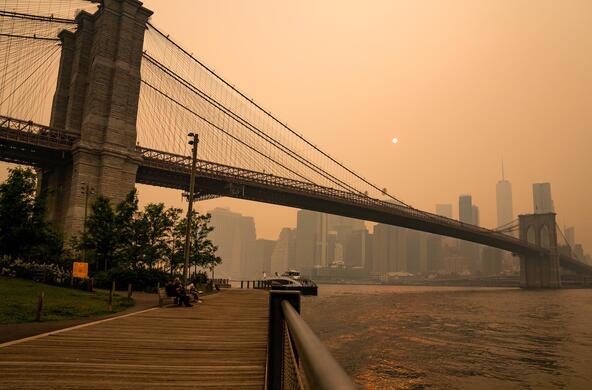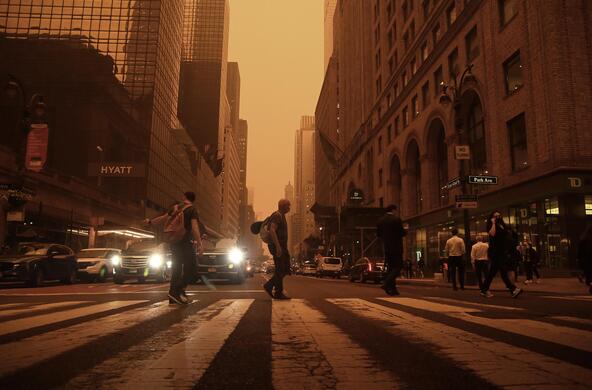Commentary first appeared in the Adirondack Almanac.
Attitudes about fire management in the Adirondack park are captive to both legacies of the past and expectations of future risk. Both of those are poor foundations for wise and effective fire policy. The conditions that led to past fires are not necessarily present today, and there is enormous uncertainty about how climate change will alter future fire risk.
The catastrophic 1903 and 1908 fires in the Adirondacks – fueled by slash from vast clearcuts and sparks from early trains – were part of the impetus for nationwide policies of indiscriminate fire suppression for the remainder of the 20th century. In the West, this was a major contributor to the accumulation of fuel that can make fires almost impossible to control.
Fire suppression in oak/hickory forests of the eastern U.S. has had almost exactly the opposite effect, making those forests less flammable and contributing to the decline in the abundance of fire-dependent oaks and the rise of fire-sensitive maples.
Fire has been a natural disturbance and an important source of biodiversity within the park throughout post-glacial history. Some of our most unique and threatened ecosystems are fire-dependent pine barrens that will disappear without deliberate reintroduction of an appropriate fire regime.
There are also many fire-adapted species like white and red pine that owed much of their abundance in presettlement forests to natural fires, and then increased in abundance thanks to the dramatic rise in fire frequency following European settlement. But the majority of upland forests within the park have often been referred to as “asbestos forests,” dominated by fire-sensitive species like beech and sugar maple, where fires spread slowly if at all.
The various models used to project future climates generally agree that average annual precipitation in the Northeastern United States will increase slightly as greenhouse gas emissions continue to increase. But as recent flooding will attest, it’s the variability in rainfall amounts that really matters.
The existing climate models are simply too uncertain about rainfall variability for me to have any confidence that we know how much more likely extreme droughts are in the next few decades, and the existing climate data are too sparse for me to have confidence in predictions of future drought frequency or severity from purely statistical analyses.
All of this poses a real challenge to refinements in fire management within the park. Blanket fire suppression policies have compelling practical advantages, particularly when it comes to protecting human life and property. Natural resource managers are naturally and appropriately risk averse. But blanket policies risk losing the potential ecological benefits of fire, particularly in the most fire-dependent ecosystems.
Both the science and the tools needed to implement much more adaptive fire management exist, but would require significant investment in staff and infrastructure by DEC. Given the many different threats to Adirondack ecosystems, and all of the other demands on an already over-burdened state workforce, I’d personally be hard pressed to lobby for that investment.
A welcome compromise would be for the state to work with local towns and fire companies and fire ecologists from local universities to identify the most threatened fire-dependent ecosystems where the appropriate fire regime could be safely reintroduced. And if DEC staff are willing to “take the heat,” I’d welcome some risk-taking in allowing spot fires at high elevations within the Adirondack Forest Preserve to burn themselves out, with benefits for both biodiversity and vistas.
Forests produce flammable material and in the right conditions they definitely can and do burn. How often fires happen, and what kind of fires – big or small, mild or severe – is a “fire regime.” A fire regime is shaped by three things: vegetation, climate, and ignitions. The question is whether the fire regime of the Adirondacks poses a risk, or is changing to where it will.
There is a mix of forest types in the Adirondacks, but most of them are not fire prone – the fuels they produce are difficult to ignite and fires spread slowly. Even in the more flammable forest types, the Adirondack climate is moist enough to discourage fire. The only source of ignitions besides people is lightning, which is almost always accompanied by rain in this part of the country – the Adirondacks get about 3-4 lightning-caused fires a year, which is about a fifth of those caused by campfires.
Climate is changing – warmer, but also wetter. Vegetation is changing, too – as forests age, they tend to change in ways that decrease the likelihood of fire. Understories become shadier, cooler, moister. Less-flammable forbs replace more-flammable grasses and shrubs; with enough time, less-flammable maples and hemlocks replace more-flammable birches and pines.
Litter – leaves and sticks, AKA “fuel” – does accumulate but its qualities (species, size, moisture content, decay) matter more than its quantity. Our forests are not very flammable and they are becoming less so. Each decade since at least the 1940s has had fewer fires in New York than the decade before, in spite of warmer weather (Wildland Fires and Acres Burned in New York State – NYSDEC).
With respect to forest health in the Adirondacks, there are more pressing concerns than fire. Invasive species, including insects and diseases, will kill far more trees and have far more dramatic impacts on Adirondack ecosystems in the coming decades than even the worst-case fire scenario would.
Adirondack forests are not at greater risk for big fires in the near future than they have been for some time (ie, very low but non-zero risk) – there is plenty of reason to expect the decreasing fire trend of the last several decades to continue or level off. Fire attracts attention and generates fear; it also distracts from less eye-catching but more important issues.








